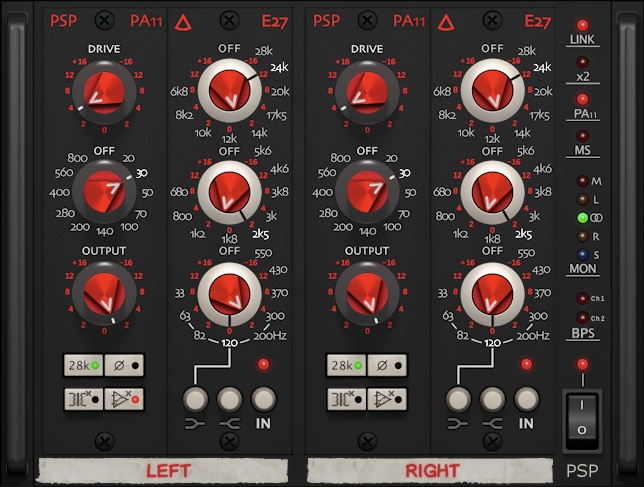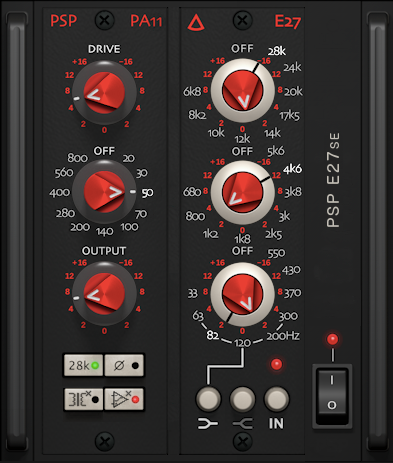New Software Review: E27 Multistage EQ by PSP

The E27 is more than just an EQ—the included PA11 preamp module provides added flexibility via its Drive control, HPF and the ability to remove the “transformer” from the circuit.
Polish plugin designer PSP Audioware has recently released a very handy, flexible, powerful—and not to mention very good-sounding—EQ plugin: The E27.
The E27 is a software re-creation of a 500-series EQ module, the Avedis E27, enhanced with a number of features both mixers and mastering engineers will appreciate.
Features
At first glance, the E27 interface strongly resembles the classic API 550A EQ, yet the E27 is much more comprehensive. For example, instead of having only five selectable frequencies for each of the three bands, the E27 has nine frequencies to choose from. Additionally, each of the three bands has a healthy ±16dB of gain or gain reduction.
In the high band, we have 6.8k, 8.2k, 10k, 12k, 14k, 17.5k, 20k, 24k and 28kHz. Like an API 550A or 550B, this band can also be set as a peak/dip-style filter or as a high shelving filter. Midrange frequencies are selectable with well-thought-out points between 680Hz, 800Hz, 1.2k, 1.8k, 2.5k, 3.8k, 4.6k and 5.6kHz, and the low band is also selectable as a low shelf or peak/dip filter, with frequency points at 33, 63, 82, 120, 200, 300, 370, 430 and 550Hz.
Even though it might appear to be only a 3-band EQ on the surface, the PSP E27 offers more than just three bands of equalization. Just hit the “x2” button on the right-hand side of the GUI window and suddenly the E27 doubles itself, and now we have a 6-band EQ! (This is a great feature that more EQ plugin manufacturers should consider including.) Three bands of equalization is often not enough, but instead of having to throw another instance of the plugin on (or adding a different one), everything you need to adjust can be tackled within a single instance of the E27.
On the right-hand panel is the “PA11” button, which allows you to access to even more tonal control by adding in the PA11 preamp module which it pops into the GUI. In the PA11 module, you can disable the “transformers” and remove them from the signal chain for a different, less colored sound. There is also a button that disables harmonic distortion from the circuit for a cleaner, less affected (and therefore slightly less analog) sound. Mastering engineers in particular would likely find these options very useful. In fact, there’s a few features in the PSP E27 that mastering engineers would appreciate—more on that later.
The PA11 module also includes a highpass filer with a very wide range, offering eleven frequencies selectable from 20Hz all the way up to 800Hz, as well as a “28k” button which extends and enhances the top end of the circuit, a phase flip button (which the user manual states uses “a special algorithm with less noise and clicks than the normal algorithm”), and a very subtle “Drive” control. The Drive control should not be mistaken for a distortion unit, however; it provides a gentle thickening more so than it does a noticeable fuzz.

When purchasing the E27, buyers also get the E27 SE—a more streamlined version which doesn’t include the “x2” button or the added stereo routing capabilities, which makes for a lighter CPU load.
For stereo use, PSP has taken this plugin further than most manufacturers go. Both channels are visible (as opposed to just having one visible set of controls covering both channels) and can easily be linked or unlinked, even during playback in Pro Tools. The pots move together when they are linked. I found the coolest part of this feature to be the fact that you can unlink the two sides, adjust one, and then relink.
For a mastering or restoration engineer, or perhaps for someone EQing a stereo mic where maybe one capsule sounds duller than the other, this could be handy as you can boost/cut one side a little more than the other to match the channels, and then re-link for continued stereo equalizing.
The E27 also provides numerous routing and monitoring options, allowing for Mid-Side processing and monitoring of any channel, both channels, mono, or just the sidew. Each channel is easily bypassable, independently or globally.
Another small but useful hidden feature is that the “Off” switch for each band can be engaged and disengaged while returning to the last frequency selected. This means that there is no flipping through frequencies or adjusting gain pots to do A/B comparisons to turn off one band and check what your EQ tweak is actually doing.
But most importantly, how does the PSP E27 sound?
In Use
Upon first trying it, three terms come to mind: “Analog hardware,” “lively,” and “clear.” “Hi-Fi” could also be another apt descriptor. Right away, I felt like the sound of the E27 was not that of a plugin EQ, and sounded more like an expensive, high-end, tight, mean, yet clean hardware EQ. It’s somewhat reminiscent of the API EQ sound, but clearer.
The low band has a wonderful weight with a very cool roundness, slightly reminiscent of the tone of the low end boost on a Pultec. On many EQ plugins—especially older ones—a low end boost sounds mathematic but not necessarily heavy, and not as effective as a good analog EQ. This is not the case with the E27.
The mid band has a great edge and musical aggressiveness, as does the high frequency band, which seems to have endless clarity and three-dimensionality, but with a certain “hardness” that is again reminiscent of the API sound.
Personally, I don’t think that there is any single EQ that sounds perfect for every application, so I wouldn’t go so far as to say this is the only EQ you will ever need. However, this may be the most analog-sounding plugin EQ I’ve ever used. It just has a depth, resolution and vibe that does not sound digital whatsoever. PSP (and Avedis) have done great work with the E27.
To Be Critical
There isn’t a lot to complain about when it comes to the E27 (in fact, I’m digging pretty deep just to find something bad to say about it). No, it does not have the thickness or shimmer of the subtle fuzzy harmonics a vintage Neve 1073 provides, but then again, what other EQ does?
Perhaps there are some out there that have a nice pillowy sound that dip smoothly to soften harsh midrange tones, which is one application where the E27 might find itself outperformed, but again… I’m digging. In general, this plugin outshines most of its competition in so many departments.
Summing it Up
The PSP E27 is available online from PSP for an extremely reasonable price of $149, and is supported by Windows or Mac in 32 or 64-bit resolution, in VST3, VST, RTAS and AAX formats—and also in AudioUnit format for Mac users.
Along with the standard E27, buyers also get the E27 SE, which is the same plugin, only stripped down so that it does not include the “x2” button or the various stereo routing features, thereby requiring less system usage.
The E27 is another great creation from the developers at PSP Audioware, and in this reviewer’s opinion, is a plugin that any engineer will instantly appreciate.
Please note: When you buy products through links on this page, we may earn an affiliate commission.






